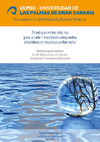Please use this identifier to cite or link to this item:
https://accedacris.ulpgc.es/handle/10553/76677
| Title: | Estrategias metodológicas para la determinación de compuestos citostáticos en muestras ambientales | Other Titles: | Methodological strategies for the determination of cytostatic compounds in environmental samples | Authors: | Santana Viera, Sergio | Director: | Sosa Ferrera, María Zoraida Torres Padrón, María Esther |
UNESCO Clasification: | 2301 química analítica 2391 Química ambiental |
Keywords: | Compuestos citostáticos Extracción en fase sólida (SPE) Extracción por adsorción (FPSE) Extración asistida por microondas (MAE) |
Issue Date: | 2020 | Abstract: | El cáncer es una de las principales enfermedades del siglo XXI que produce un crecimiento descontrolado de células en una parte del cuerpo, pudiendo invadir otras zonas y causar la muerte. Uno de los tratamientos es la quimioterapia, que se basa en el uso de medicamentos, conocidos como citostáticos o antineoplásicos, para frenar la división celular o causar la muerte de las células. Después de ser administrados y excretados por el paciente pueden continuar activos, incluso después de pasar por la estación depuradora de aguas residuales. Se tratan de compuestos que, además, son mutagénicos por lo que bajas concentraciones podrían tener efectos adversos en los organismos. Por ello, se hace necesario desarrollar metodologías analíticas capaces de extraer y preconcentrar estos compuestos de matrices.
El objetivo de esta Tesis Doctoral es aportar una visión amplia y consolidada del conocimiento sobre métodos de extracción y determinación que permitan estudiar la presencia y distribución de compuestos citostáticos en el medioambiente. Se detectaron y cuantificaron, mediante diversas metodologías, compuestos citostáticos en aguas residuales de hospitales y diversas estaciones depuradoras de la isla. Cancer is one of the main diseases of the 21st century that produces uncontrolled growth of cells in one part of the body, being able to invade other areas and cause death. One of the treatments is chemotherapy, which is based on the use of drugs, known as cytostatics or antineoplastics, to slow down cell division or cause cells to die. After being administered and excreted by patients, they can continue being active, even after passing through the wastewater treatment plant. These compounds are also mutagenic, so, low concentrations could have adverse effects on organisms. Therefore, it is necessary to develop analytical methodologies capable of extracting and pre-concentrating them from different matrices. The objective of this Doctoral Thesis is to provide a broad and consolidated view of the knowledge on extraction and determination methods that allow studying the presence and distribution of cytostatic compounds in the environment. Cytostatic compounds were detected and quantified in hospital wastewater and in various wastewater treatment plants on the island using various methodologies. |
Description: | Programa de Doctorado en Calidad Ambiental y Recursos Naturales por la Universidad de Las Palmas de Gran Canaria | URI: | https://accedacris.ulpgc.es/handle/10553/76677 |
| Appears in Collections: | Tesis doctoral |
Page view(s)
461
checked on Dec 28, 2024
Download(s)
399
checked on Dec 28, 2024
Google ScholarTM
Check
Share
Export metadata
Items in accedaCRIS are protected by copyright, with all rights reserved, unless otherwise indicated.
